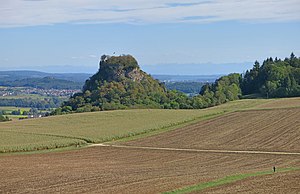High crows
| High crows | ||
|---|---|---|
|
View from the northwest |
||
| height | 636.6 m above sea level NHN | |
| location | Baden-Wuerttemberg , Germany | |
| Mountains | Hegau | |
| Coordinates | 47 ° 47 '56 " N , 8 ° 49' 14" E | |
|
|
||
| Type | Spring tip | |
| rock | Phonolite | |
|
The high crow from the south-east (2006) |
||
The Hohenkrähen ("Krayen") is a mountain of volcanic origin north of Singen im Hegau , located in the district of Konstanz in Baden-Württemberg , Germany .
Location and surroundings
The mountain is located between the villages Duchtlingen , Schlatt among crows and Mulhouse on the district Duchtlingen the municipality Hilzingen .
height
The summit of the Hohenkrähen is at a height of 636.6 m above sea level. NHN and protrudes from the area as a 200 meter high phonolite cone on which the Hohenkrähen castle ruins are located. The mountain offers a good view of the Hohentwiel , the Mägdeberg and the western Lake Constance area .
history
colonization
Individual finds indicate that the Hohenkrähen has been inhabited since the Neolithic Age . Romans - in 1983/84 a total of thirteen Roman coins from the first half of the 2nd to the middle of the 4th century were found in the debris of the Hohenkrähen - and the Alemanni used the mountain as a place of worship.
The construction of Hohenkrähen Castle is dated between 1180 and 1190 - it was built by the Lords of Friedingen , who from 1191 were also called "de Craien". During the Thirty Years' War the castle was burned down by the fortress commander of Hohentwiel Konrad Widerholt . Since then, Hohenkrähen Castle has been in ruins and is no longer used.
After many changes of ownership, the Grauer Reiter scouts leased the ruins from Count Douglas Freiherr von Reischach in 1956 . Hohenkrähen Castle has been used as a " youth castle" ever since .
Botanical
On rare plants of Phonolithkegel houses, among others, the following plants: Gray cinquefoil , Bleicher Wallflower ( Erysimum crepidifolium ), Mountain Alyssum , Festknolliger Corydalis , Finger Toothwort ( Dentaria pentaphyllos ), Yellow Sage ( Salvia glutinosa ) and mountain leek ( Allium senescens ) . The mountain was complete and is still partially covered with linden forest today .
Since 1983 the mountain has been designated as a nature reserve " Hohenkrähen ".
See also
Web links
Individual evidence
- ↑ Map services of the Federal Agency for Nature Conservation ( information )
- ↑ Hans Stather: Hohenkrähen . In: The Roman Hegau, chapter "Alphabetical references", page 144f




